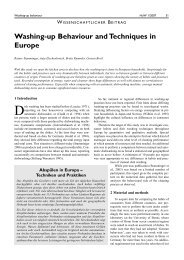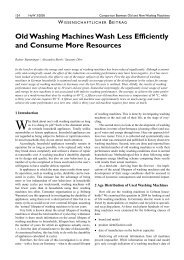Development of a novel mechatronic system for mechanical weed ...
Development of a novel mechatronic system for mechanical weed ...
Development of a novel mechatronic system for mechanical weed ...
Create successful ePaper yourself
Turn your PDF publications into a flip-book with our unique Google optimized e-Paper software.
Results and discussion<br />
96<br />
5.3.4 Algorithm <strong>for</strong> the online control <strong>of</strong> the hoeing tool’s<br />
rotational speed<br />
The idea built into the algorithm <strong>for</strong> online control <strong>of</strong> the hoeing tool’s rotational<br />
speed is based on the theoretical approach presented in the previous chapter.<br />
Be<strong>for</strong>e the rotational speed unew can be calculated, it is necessary to know the<br />
relative distance between the hoeing tool and the plant which need to be hoed,<br />
the latest <strong>for</strong>ward speed V, latest angular position <strong>of</strong> the hoeing tool and latest<br />
rotational speed uold. With assumption that the <strong>for</strong>ward speed will not change on<br />
the next section <strong>of</strong> travelled distance equal to the average intra-row distance<br />
between plants d, the <strong>for</strong>ward speed can be calculated using the following<br />
equitation:<br />
zc( tL) − zc( tL−1)<br />
V =<br />
t − t<br />
L L−1<br />
(5.18)<br />
where zc(tL) is the absolute coordinate <strong>of</strong> the last detected plant’s centre<br />
position in direction <strong>of</strong> traveling, zc(tL-1) is the absolute coordinate <strong>of</strong> the last but<br />
one detected plant’s centre position and the tL and tL-1 are the time stamps<br />
when the detection unit was above the centre position <strong>of</strong> the last and last but<br />
one plant successively.<br />
Knowing the distance and the <strong>for</strong>ward speed it is possible to estimate the time<br />
in which the hoeing tool will arrive to the position exactly above the plant centre<br />
position.<br />
T<br />
z ( t ) − z( t) − D<br />
V<br />
c L−1 sens−hoe = (5.19)<br />
where z(t) corresponds to the absolute position <strong>of</strong> the detection unit <strong>for</strong> plant<br />
detection.<br />
At that moment the angular position <strong>of</strong> the hoeing tool φrecent needs to be<br />
acquired. Because <strong>of</strong> non uni<strong>for</strong>m distances between plants it can happen that<br />
one very fast rotating sequence can be followed by one very slow sequence or<br />
vice versa. It means that the <strong>system</strong> needs to accelerate or decelerate<br />
depending on the recent angular position <strong>of</strong> the hoeing tool. As the angular





